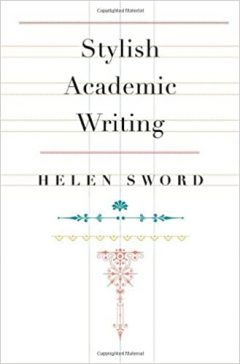Review: Stylish Academic Writing

Stylish Academic Writing
By Helen Sword
Harvard University Press, 2012
In Stylish Academic Writing, Helen Sword tackles a question often posed by readers of academic papers and books: why do many academic authors fail to write engaging academic prose? Thus, the essential issue Sword targets is the ever-present, “massive gap between what most readers consider to be good writing and what academics typically produce and publish.”
Her response, one which she supports with rigorous research and cogent argument, is actually the book’s two-pronged thesis: first, “elegant ideas deserve elegant expression” and, second, academic conventions, though appearing incredibly rigid at first glance, do allow academic writers enough flexibility to write and structure their texts creatively. This injection of creativity animates the text and transforms the reading experience from a chore to be avoided if at all possible to an experience characterized by engagement and pleasure.
In line with her emphasis on creativity, Sword is not prescriptive. She delves into the ways in which writers can work on improving “elements of style” such as titles, sentences, and structure—in addition to including a list of actionable tips at the end of each chapter. However, she does not provide a one-size-fits-all writing guide which describes how your own academic writing should look like. According to Sword, “academic writing is a process of making intelligent choices, not of following rigid rules.” She informs writers of the choices available and encourages them to think hard about how they express ideas and why they express them the way they do. These choices will essentially make or break the style of the text.
Thus, if you come to this book expecting to receive advice on how to write a literature review or a methodology section, you will be disappointed. Sword assumes her readers know the conventions but need help improving their writing style. In short, the emphasis here is on stylish, not on academic writing as such.
Overall, this book is a great resource for graduate students, partly because many of them have yet to internalize the disciplinary conventions so deeply. This also means that if you are new to academic writing and want to learn both the basic conventions and how to write stylish academic prose, a good approach would be to read this book alongside a more traditional guidebook about academic writing.
Stylish Academic Writing is highly informative, witty, an all-around pleasure to read. It demonstrates to academic writers that they do not have to choose between convention and style. Rather, the real formula goes as follows: convention plus creativity equals style.